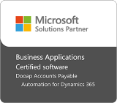
The stakes have never been higher for automating the accounts payable process.
The operational disruption caused by the shift to work from home, combined with the mounting pressure to provide senior management with visibility into cashflow and spending, has become the impetus and in some instances the business case for automating the accounts payable process.
The right automated accounts payable solution can have significant positive impacts on an organization. Here are four benefits any organization can revel in with accounts payable automation:
- Lower invoice processing costs. Organizations are more closely scrutinizing their costs these days. Automating invoice processing is one way for most organizations to trim unnecessary expense. Best-in-class accounts payable departments spend less than one-fourth as much as their peers to process a single invoice ($2.18 versus $12.60), according to Ardent Partners’ 2019 State of ePayables Report. It is no secret how best-in-class accounts payable departments achieve considerably lower AP costs. Compared to their peers, best-in-class accounts payable departments are far more likely to have deployed AP automation such as document scanning, dynamic workflows, and digital workflows. In fact, compared to other accounts payable departments, nearly twice the percentage of best-in-class accounts payable departments use electronic invoicing, Ardent Partners finds. AP automation reduces the manual tasks (think: opening mail, keying invoice data, shuffling paper, and chasing down information) that drive up the cost of processing invoices. If your organization wants to reduce its costs, automating the accounts payable process is a good place to start.
- Faster invoice processing turnaround. Everywhere you look, things move faster these days. Everywhere, that is, except accounts payable. Most accounts payable departments are bogged down by a seemingly endless list of manual processes: opening mail, keying and rekeying data, tracking down approvers, routing invoices for approval, reconciling invoices and payments, and generating reports. All the while, accounts payable professionals must be mindful of a myriad of business rules, best practices, regulations, and auditor guidelines for how invoices should be processed and paid. All this takes considerable time. Slow invoice approvals result in late payment penalties, missed early payment discounts, calls and e-mails from (frustrated) suppliers wondering where things stand, and trouble forecasting cash. AP automation eliminates the manual tasks that slow invoice approvals down. Automating the accounts payable process enables invoices to flow digitally through the approval process, with staff intervening only when necessary. Automation is a big reason that best-in-class accounts payable departments process invoices in less than one-third the time of their peers (2.9 days versus 10.8 days), according to Ardent Partners’ 2019 State of ePayables Report.
- Fewer invoice exceptions. Invoice exceptions are the bane of many accounts payable departments. Sixty-two percent of accounts payable leaders say that exceptions are their department’s top pressure, according to Ardent Partners’ 2019 State of ePayables Report. Resolving exceptions often requires lots of back-and-forth phone calls and e-mails between internal stakeholders and suppliers to sort things out. All the time that accounts payable staff spend trying to resolve invoice exceptions increases the chances of late payment and is time that staff cannot spend on higher-value activities such as data analysis. There are lots of underlying causes of invoice exceptions and often the problems that accounts payable must solve are not of their own making: a discrepancy between the invoice and the purchase order, supplier error, no purchase order, an incorrect purchase order, and coding errors, to name a few. Automation enables accounts payable departments to identify invoice exceptions earlier in the process to head-off downstream complications and accelerate the resolution of exceptions through instant access to information and online tools that facilitate collaboration among internal stakeholders and suppliers. Some electronic invoicing solutions also reduce the possibility of invoice exceptions. The fact that best-in-class accounts payable departments experience less than half the percentage of invoice exceptions as their peers (10.1 percent versus 23.3 percent) can largely be attributed to accounts payable automation.
- Less paper handling. Forty-seven percent of accounts payable leaders say that eliminating paper and manual tasks is their department’s top priority, according to Ardent Partners’ 2019 State of ePayables Report. Even in this Digital Era, most accounts payable departments manually handle most of the invoices they receive from suppliers, IOFM reports. In fact, many accounts payable departments manually handle invoices received electronically as PDF e-mail attachments because they lack the AP automation to process them automatically. Manual invoice handling contributes to higher costs, increases the possibility of errors, slows invoice approval processes down, and makes it harder for accounts payable leaders to know where things stand. Automating the accounts payable process makes it possible for organizations to receive, approve, and post invoices directly to their enterprise resource planning (ERP) application, without human operator intervention. The touch-free or straight-through processing of invoices is made possible by automated accounts payable capabilities such as electronic invoicing, two-way and three-way matching of invoices to purchase orders and proof-of-delivery receipts, and seamless integration with ERP applications. Posting more invoices straight-through goes a long way to helping an accounts payable department achieve fast and definitive results. Best-in-class accounts payable departments post more than three times the percentage of invoices straight-through than their peers (65.3 percent versus 19.2 percent), according to the findings of Ardent Partners’ 2019 State of ePayables Report. Straight-through posting of invoices also provides the scalability that accounts payable departments need to handle higher invoice volumes without hiring additional staff.
If you find these accounts payable automation benefits compelling, you are not alone.
Seventy-one percent of accounts payable leaders say they plan to automate further to address the challenges of the sudden shift to remote working, according to an online survey conducted this summer by the Institute of Finance and Management (IOFM). Even accounts payable leaders that describe their department as being “largely automated” plan to deploy more AP automation.
Automating the accounts payable process provides the types of benefits that organizations need now.
Learn more about how to get started in the accounts payable automation process.








